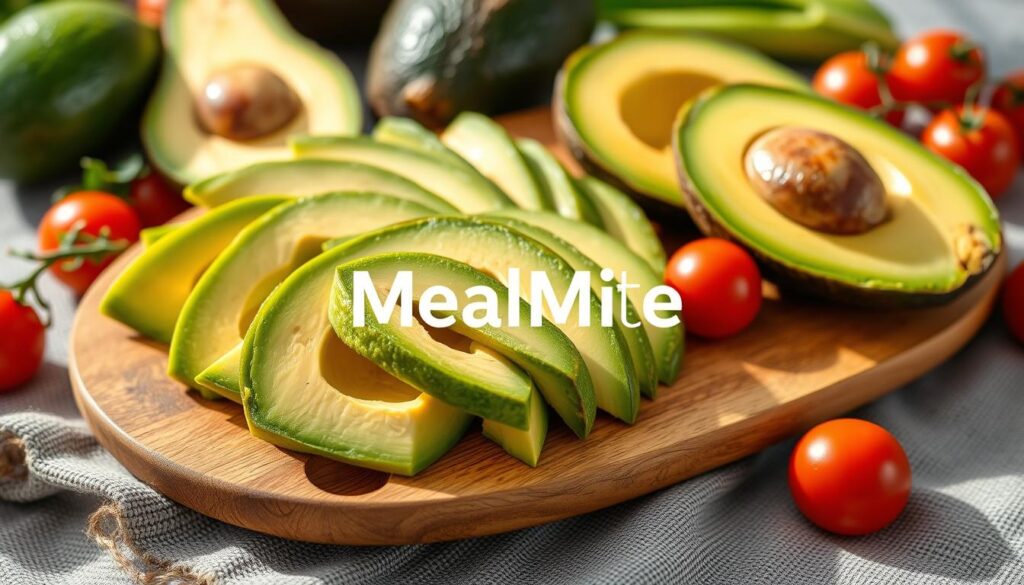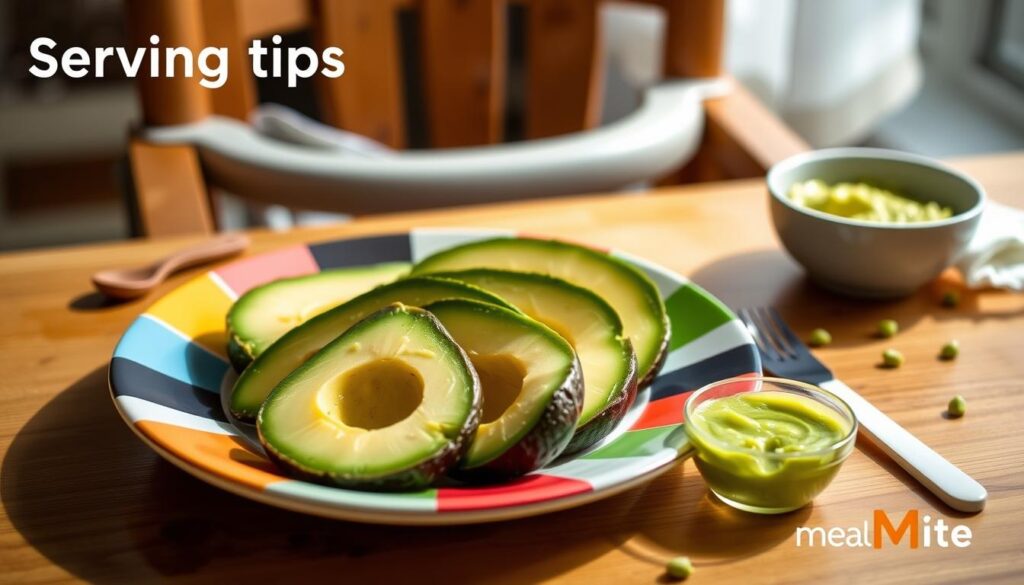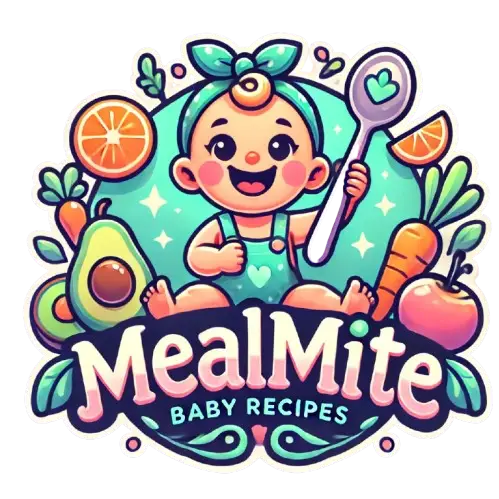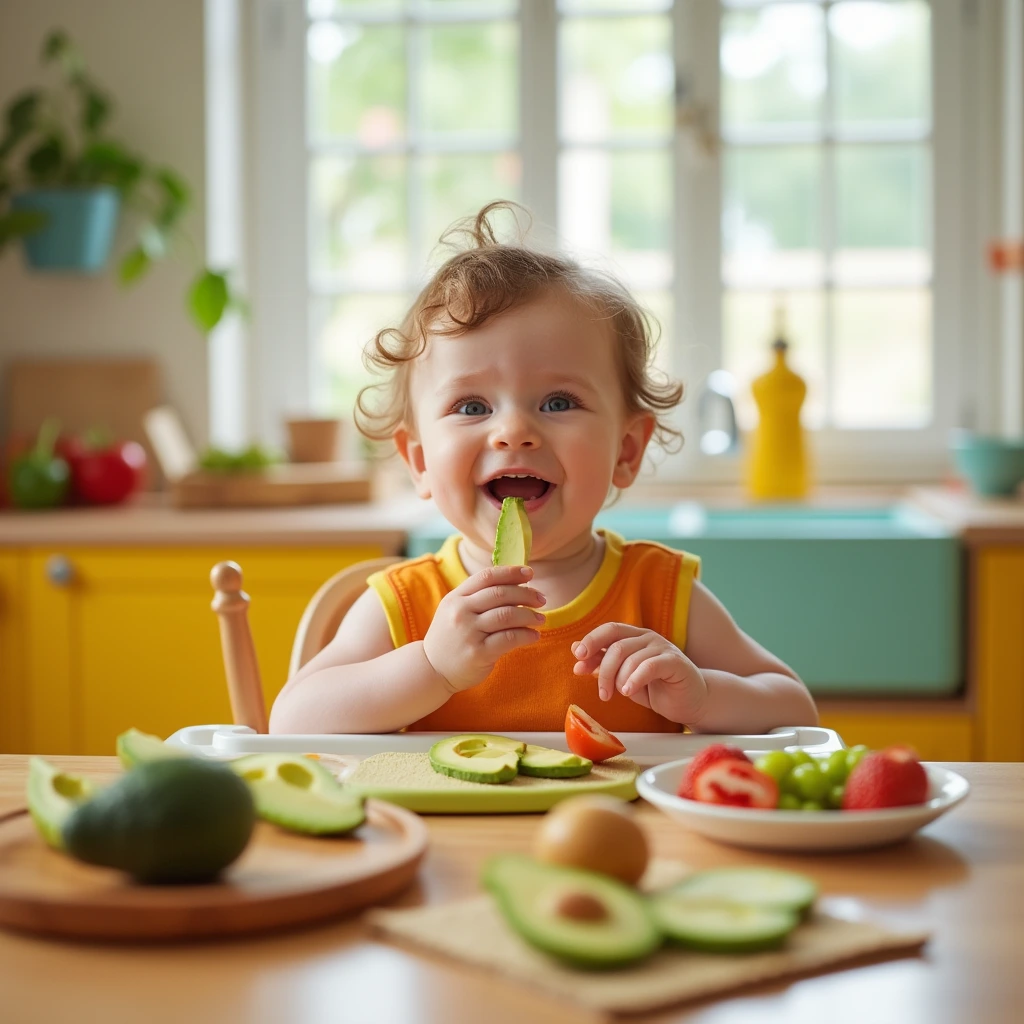Table of Contents
Did you know avocados have more potassium than bananas? They are also full of 20 different vitamins and minerals. This makes sliced avocado wedges a healthy avocado snack and a great first finger food for babies starting solids.

Avocados are cheap and easy to find, making them perfect for introducing solid foods. Their creamy texture and mild taste are great for a baby’s growing taste buds, making starting solid foods a breeze and fun.
Introducing avocados as a first finger food means your baby gets a nutrient-rich food. It’s full of healthy fats that help with brain growth. You can serve them alone or with other healthy foods. Avocado wedges bring both variety and health benefits to your baby’s meals.
Key Takeaways
- Avocados offer more potassium than bananas and contain 20 different vitamins and minerals.
- A creamy texture and mild flavor make avocados ideal for a baby’s first finger food.
- Highly affordable and available year-round, avocados are a convenient choice for baby food.
- Rich in healthy fats, avocados support brain development in babies.
- Avocado wedges are versatile and can be paired with other nutritious foods.
Introduction to Sliced Avocado Wedges
Avocados are great for food and health, making them perfect for baby food. They are soft and creamy, great for babies starting solid foods. Learning to cut avocado wedges is important for safety and ease.
Preparing sliced avocado wedges is easy. Knowing how to slice them right can prevent accidents. This way, you make wedges that babies can easily hold.
Ripe avocados are full of good stuff like healthy fats and vitamins. They are good for your baby’s growth. Here’s why avocado wedges are good for your baby’s meals:
| Benefit | Details |
|---|---|
| Soft Texture | The creamy consistency is perfect for infants transitioning to solid foods. |
| Rich in Nutrients | Provides essential vitamins and healthy fats to support growth. |
| Convenience | Easy to prepare and ideal for finger food portions. |
| Versatility | Can be used in numerous dishes, from sandwiches to salads. |
Choose a ripe avocado by pressing it gently. It should feel soft but not mushy. For the best slices, use a sharp knife and cut around the pit.
Why Avocado is the Perfect First Finger Food
Avocado is a great first finger food for babies. It’s soft and easy to mash with their gums. Its mild taste and creamy texture are loved by infants, making mealtime fun. Plus, avocados are safe for most babies, making them a good start to solid foods.
Avocados are packed with nutrients, making them a top choice for nutritious baby food. They have healthy fats that help babies grow without gaining too much weight. They also have more potassium than bananas, which is key for muscle and motor skill development.
Avocados also have antioxidants that protect babies’ eyes from UV rays. They have folic acid, which is vital for a baby’s brain and nervous system. Babies can start eating avocados at 4-6 months, in forms like puree, mashed, or sliced.
| Key Nutrients | Benefits |
|---|---|
| Monosaturated Fatty Acids | Supports healthy growth without weight gain |
| Potassium | Essential for skeletal muscle development |
| Antioxidants | Protects eyes from UV damage |
| Folic Acid | Vital for nervous system and cognitive development |
Avocados are less likely to cause choking, making them a safe soft finger food for baby-led weaning. They can be served in many ways, like blended with breast milk or mixed with lemon or lime. Avocados are also great with veggie sticks, offering many healthy options for your baby’s meals.
Health Benefits of Avocados for Babies
Avocados are full of important nutrients. They are great for babies because they support brain health and boost immunity. This makes them a top choice for baby food.
Rich in Nutrients
Avocados have lots of vitamins like K, C, E, and B-6. These vitamins are key for a baby’s health. A medium avocado has 80 calories and lots of vitamins and minerals.
It also has 3 g of fiber and 6 g of healthy fats. Plus, it has 250 milligrams of potassium. This makes avocados a great snack for babies, giving them calories without extra weight.
Supports Brain Development
Avocados have healthy fats, including omega-3s. These fats are vital for a baby’s brain growth. A 50 g serving of avocado has 4 mg of vitamin C.
It also has 10% of the Daily Value of folate. Folate is important for the nervous system and brain. Eating avocados helps your baby’s brain develop, making them a key part of baby food.
Boosts Immunity
Avocados are full of antioxidants and have anti-inflammatory properties. These help strengthen your baby’s immune system. They also have lutein, which protects your baby’s eyes from harm.
Avocados have 136 micrograms of lutein per serving. Their fiber helps prevent diabetes and keeps your baby healthy. This makes avocados a great snack for babies.
Adding avocados to your baby’s diet is tasty and good for them. It offers many health benefits, helping them grow and stay healthy.
Choosing the Right Avocado for Your Baby
Choosing the right avocado for your baby is key for their nutrition. Look for avocados that are ripe but not too ripe. They should be soft to the touch but not mushy. This means they’re ready to eat and full of good nutrients for your baby.
To check if an avocado is ripe, look at its color and feel. A ripe avocado has a darker skin, almost black, and a bumpy texture. It should feel slightly soft when you press it. If it’s too hard, leave it at room temperature for a few days to ripen.
Adding avocados to fresh avocado recipes for your baby is a great way to give them nutrients. Avocados have healthy fats that help with growth and weight control. They also have more potassium than bananas, which is good for muscles and motor skills in babies.
- Color: Look for a dark green or blackish hue, indicating ripeness.
- Texture: A slight bumpiness and softness when pressed gently.
- Firmness: Soft but not mushy, should yield slightly to pressure.
Avocados take about 4-5 days to ripen at room temperature. Once ripe, store them in the fridge to keep them fresh. This way, they stay good until you’re ready to make your fresh avocado recipes for your baby.
Avocado is a top pick for first foods for babies. It’s full of calories and nutrients that are great for weaning. Start introducing avocados when your baby starts solids, usually around six months. Their soft texture makes them easy to prepare and serve, so your baby can enjoy and benefit from this nutritious fruit.
How to Prepare Sliced Avocado Wedges
Start by picking a ripe avocado. Use the right slicing techniques and store leftovers well. These steps help make your avocado wedges soft and great for babies.
Selecting a Ripe Avocado
Choosing a ripe avocado is key. Avocados should be soft but not too mushy. The skin should be dark and a bit bumpy. This means they’re ready to use and will be perfect for your baby.
Slicing Techniques
Learning to cut avocado wedges is important. Cut the avocado lengthwise around the seed. Twist the halves and remove the pit with a spoon. Then, slice each half into four wedges. This way, the slices are just right for your baby’s small hands.
Storing Leftover Avocado
Storing avocados right can stop them from turning brown. Sprinkle lemon or lime juice on leftover wedges. Then, put them in an airtight container or wrap them in plastic wrap. Store them in the fridge. This keeps them fresh for a longer time.
By following these steps, your avocado wedges will be ready and stored well. They’re a healthy and easy snack for your baby.
Tips for Serving Sliced Avocado Wedges
Serving sliced avocado wedges to your baby can be both fun and nutritious. Here are some avocado wedges serving ideas that will enhance your baby’s eating experience. They ensure they get the most out of this healthy avocado snack.
- Combining with Other Nutritious Foods: For added nutrition, try serving avocado wedges alongside cooked sweet potato, soft-cooked carrots, or steamed broccoli florets. This variety provides a balanced and colorful plate.
- Presentation Tips: Enhance the visual appeal by arranging the avocado wedges in fun shapes or patterns on the plate. Consider making an avocado rose by slicing the avocado thinly and rolling the pieces into a circular shape.
- Encouraging Self-Feeding: Offer avocado cubes by scoring the avocado while still in the skin to create a convenient checkerboard pattern. This makes it easier for little hands to grasp and develop fine motor skills.
- Preventing Oxidation: To keep avocado wedges fresh and green, brush them with lemon juice, lime juice, or white vinegar. Alternatively, keep the seed in half of the avocado to slow down the browning process.

Practical serving tips for baby food involve creating a pleasant mealtime atmosphere. Here are a few more ideas:
- Consistency: Ensure the avocado is ripe and soft enough for your baby to handle. Ripe avocados yield slightly to gentle pressure and vary in color depending on the variety.
- Storage: If you have leftover avocado wedges, store them in an airtight container in the fridge for up to two days. Remember to scoop off any brown layer that forms due to natural oxidation.
- Freezing: Avocados can be frozen for up to three months, although the texture may change. Use frozen avocado in smoothies or guacamole for a quick, healthy snack.
For a detailed comparison of healthy avocado snacks and their storage options, see the table below:
| Preparation Method | Storage Duration | Best Uses |
|---|---|---|
| Fresh Avocado Wedges | Up to 2 days (refrigerated) | Sliced wedges for meals or snacks |
| Frozen Avocado | Up to 3 months | Smoothies, guacamole |
Following these avocado wedges serving ideas can ensure your baby enjoys a variety of flavors and textures. They will benefit from the rich nutrients avocados offer. Happy feeding!
Creative Avocado Recipes for Babies
Introduce your baby to the wonderful world of fresh avocado recipes. Avocados are packed with essential nutrients and healthy fats. They are an excellent choice for healthy baby food recipes. Here are three creative and nutritious ways to prepare avocado for your little one.
Mashed Avocado with Banana
This simple combination of mashed avocado and banana provides a sweet and creamy snack for your baby. Bananas add natural sweetness and vitamins. Avocados offer healthy fats and fiber.
Avocado Puree with Added Spices
Elevate your baby’s palate with avocado puree enhanced with mild spices like cumin or cinnamon. This twist not only introduces new flavors but also enhances the nutritional profile of the puree. Avocado puree is a fantastic way to incorporate these healthy baby food recipes into their diet.
Avocado Slices Rolled in Hemp Seeds
Avocado slices rolled in hemp seeds not only add texture but also boost nutrient intake. Hemp seeds are rich in protein and omega-3 fatty acids. They complement the healthy fats found in avocado. Plus, this method aids in developing your baby’s motor skills as they learn to grasp and self-feed.
Benefits of Including Avocado in Baby-Led Weaning
Adding avocados to baby-led weaning brings many health benefits. It makes starting solid foods easier. Avocados are packed with nutrients, making them great for healthy baby food recipes.

Avocados have fats that are good for the brain. One serving has about 80 calories, 4g of carbs, 1g of protein, and 7g of fat. They also have 244mg of potassium and 3g of fiber. These nutrients help make baby food nutritious.
The creamy texture of avocados is great for babies. It can be mashed for younger babies or sliced for older ones. This helps with grasping and sensory skills.
Preparing avocados is easy and fast. A medium ripe avocado gives about four servings in 2 minutes. To keep them fresh, coat with lime or lemon juice and refrigerate for up to 24 hours or freeze for later.
Avocados add important nutrients like calcium, iron, folate, and vitamin K to baby food. They can be mixed into many recipes, making meals fun and nutritious for your baby.
Avocados are not just healthy; they also make self-feeding easier and more nutritious. Their mild taste and ability to mix with other flavors make them a favorite among parents and babies.
Frequently Asked Questions About Avocados for Babies
When introducing avocados to your baby’s diet, parents often have several baby food questions. This avocado FAQ aims to address common concerns and provide useful information for a seamless weaning experience.
- At what age can I introduce avocados to my baby?
- What are the nutritional benefits of avocados for babies?
- Can avocados cause allergies?
- What is the best way to serve avocados to babies?
- How can I tell if an avocado is ripe enough for my baby?
By addressing these common baby food questions, we hope to provide clarity and reassurance. Avocados are a nutritious and versatile addition to your baby’s diet, offering numerous health benefits while supporting their developmental needs.
Conclusion
Introducing sliced avocado wedges as your baby’s first *finger food* has many *benefits*. Avocados are packed with vitamins, healthy fats, and nutrients. These support your baby’s health, brain growth, and immune system.
Choosing the right avocado and learning how to prepare it is easy. Look for ripe avocados that are slightly soft. Start by cutting lengthwise around the seed, then scoop out the flesh.
Proper storage is key. Refrigerate and use lemon juice to prevent browning. This keeps the avocado fresh and tasty.
Trying different *creative avocado recipes* adds variety to your baby’s diet. You can mash avocado with bananas or roll wedges in hemp seeds. Avocados are a great choice for baby-led weaning, teaching your baby to enjoy healthy foods.
With the *benefits of avocado* for your baby, you’re giving them a *healthy first finger food*. This supports their growth and development.
FAQ
At what age can I introduce sliced avocado wedges to my baby?
You can start giving sliced avocado wedges to your baby at 6 months. This is when they’re ready for solid foods. Avocados are soft and full of nutrients, making them a great first food.
How can I tell if an avocado is ripe enough for my baby?
To check if an avocado is ripe, look for a dark green to black skin. It should feel slightly bumpy. A ripe avocado will yield to pressure but not be too soft.
If the stem comes off easily and shows green underneath, it’s ready. This means it’s the perfect time to use it.
What are the primary health benefits of giving avocados to my baby?
Avocados are packed with vitamins K, C, E, and B-6, and healthy fats like omega-3. These support brain growth and overall health. They also have antioxidants and anti-inflammatory properties to boost the immune system.
How do I slice avocado wedges for my baby?
First, cut the avocado in half and remove the pit. Scoop out the flesh and slice it lengthwise into wedges. Make sure the wedges are big enough for your baby’s small hands to hold without choking.
How should I store leftover avocado to prevent browning?
To keep leftover avocado fresh, sprinkle it with lemon or lime juice. Then, cover it tightly with plastic wrap or put it in an airtight container. Store it in the fridge and use it within a day or two for the best taste.
Are avocados a common allergen for babies?
Avocados are usually safe for babies and don’t often cause allergies. But, introduce them slowly and watch for any signs of allergy, like rash or tummy troubles. If you notice anything, talk to your pediatrician.
Can I combine avocado with other foods for my baby?
Yes, you can mix avocado with other foods to make meals more interesting and nutritious. For example, mash it with a banana for a sweet treat or mix it with veggies like sweet potatoes or carrots for a tasty and healthy snack.


1 thought on “6 Delicious Pairings with Sliced Avocado Wedges for Babies”